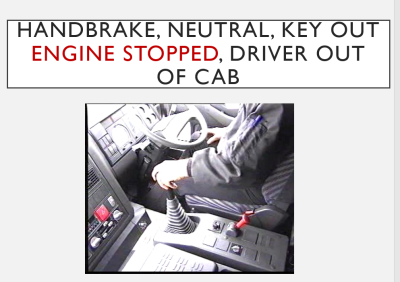lorry loading with a forklift truck

In addition to chocking the lorry wheels as indicated on the previous slide, when lorry loading with a forklift truck, other precautions should be observed. These are:
- Lorry handbrake applied
- Gears in neutral
- Engine stopped
- Keys out of ignition
- Driver out of the cab
The HSE have guidance on the safe loading/unloading of lorries which is reproduced below.
Loading and unloading lorries can be dangerous. Heavy loads, moving or overturning vehicles and working at height can all lead to injuries or death. This guidance should be followed to help avoid problems.
Loading and unloading areas should be:
- Clear of other traffic, pedestrians and people not involved in loading or unloading.
- Clear of overhead electric cables so there is no chance touching them, or of electricity jumping to 'earth' through machinery, loads or people.
- Level. To maintain stability, trailers should be parked on firm level ground,
- Loads should be spread as evenly as possible, during both loading and unloading. Uneven loads can make the vehicle or trailer unstable.
- Loads should be secured, or arranged so that they do not slide around. Racking may help stability.
- Safety equipment must be considered. Mechanical equipment and heavy moving loads are dangerous.
- Guards or skirting plates may be necessary if there is a risk of anything being caught in machinery (for example dock levellers or vehicle tail lifts). There may be other mechanical dangers and safety procedures to be considered.
- Ensure the vehicle or trailer has its brakes applied and all stabilisers are used. The vehicle should be as stable as possible.
- In some workplaces it may be possible to install a harness system to protect people working at height. Provide a safe place where drivers can wait if they are not involved. Drivers should not remain in their cabs if this can be avoided. No-one should be in the loading/unloading area if they are not needed.
- Vehicles must never be overloaded. Overloaded vehicles can become unstable, difficult to steer or be less able to brake.
- Always check the floor or deck of the loading area before loading to make sure it is safe. Look out for debris, broken boarding, etc.
- Loading should allow for safe unloading.
- Loads must be suitably packaged. When pallets are used, the driver needs to check that they are in good condition and loads are properly secured to them.
- Loads are safe on the vehicle. They may need to be securely attached to make sure they cannot fall off.
- Tailgates and sideboards must be closed when possible. If over-hang cannot be avoided, it must be kept to a minimum. The over-hanging part of the load must be clearly marked.
- If more than one company is involved, they should agree in advance how loading and unloading will happen.
- For example, if visiting drivers unload their vehicles themselves, they must receive the necessary instructions, equipment and co-operation for safe unloading. Arrangements will need to be agreed in advance between the haulier and the recipient.
- Some goods are difficult to secure during transport. Hauliers and recipients will need to exchange information about loads in advance so that they can agree safe unloading procedures.
Checks must be made before unloading to make sure loads have not shifted during transit, and are not likely to move or fall when restraints are removed.
There must be safeguards against drivers accidentally driving away too early. This does happen, and is extremely dangerous. Measures could include:
- Traffic lights.
- The use of vehicle or trailer restraints.
- The person in charge of loading or unloading could keep hold of the vehicle keys or paperwork until it is safe for the vehicle to be moved.
These safeguards would be especially effective where there could be communication problems, for example where foreign drivers are involved.
Disclaimer. The legislative information contained on this web site is my interpretation of the law based on many years in the health and safety business. A definitive interpretation can only be given by the courts. I will therefore not be held responsible for any accident/incident/prosecution arising as a consequence of anyone using any information obtained from this web site.